Bean Leaf Beetle in Kentucky Soybeans
ENTFACT-131: Bean Leaf Beetle in Kentucky Soybeans | Download PDF
Cerotoma Trifurcata (Coleptera: Chrysomelidae)
by Doug Johnson, Extension Entomologist
University of Kentucky College of Agriculture
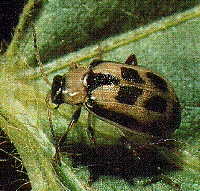
Bean leaf beetles (BLB) can be found in most soybean fields every year but economic damage is rare. These beetles are present from the time plants emerge until maturity. BLB are important pests only from seedling emergence until the first trifoliate leaf has unrolled and again during pod fill.
The adult is a 1/8 to 1/4 inch long beetle. The body is slightly convex and longer than wide. BLB color varies from light brown to dark red. Black spots and/or stripes may be present on the wing covers. All bean leaf beetles will have a backwards pointing black triangle behind the head. These insects look very much like spotted cucumber beetles but are smaller. The small rootworm-like larval stage lives below ground and feeds on soybean roots. They are rarely seen and cause no apparent damage.
BLB pass the winter as adults hiding in the soil or under crop residue and along field edges. With the return of warm spring weather, they begin to feed and lay eggs. The orange eggs are laid in small groups on the soil surface on or near the stems of soybean plants. Eggs hatch in about 11 days and the thin white larvae live in the soil for 35 to 55 days, passing through three growth stages. They then pupate and come out of the soil as adults. There are probably two and perhaps a partial third generation each year in Kentucky.
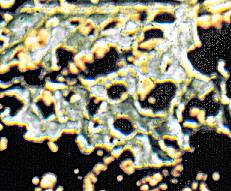
Adults feed on seed leaves (cotyledons), leaves, and pods. The most important injury, damage to the seed leaves, appears as scooped out pits. Leaf feeding appears as distinctive, almost circular holes, which are scattered over the leaf. Pod feeding is usually limited to removal of the green tissue from the pod walls, causing a scarred appearance. Occasionally, they eat through the pod wall to the bean.
Insect counts or an assessment of plant damage can be used to determine whether or not a control needs to be applied. Early in the season look for stand reduction (cotyledon stage) and heavy leaf feeding while crossing the field. If damage is noticed, try to establish that bean leaf beetle is the problem and estimate the percent stand loss. During the vegetative stages, you may estimate the percent defoliation or count the number of beetles collected using a sweep net or a shake cloth. All methods are equally reliable. Sampling for beetles should not be done prior to mid morning or when dew is present.
Sweep net procedure: Take 20-sweep samples at each sample location, sweeping the plants with a 15-inch diameter net as you walk down the row. Calculate the average number of beetles per sweep. Consider an insecticide application if the beetle count reaches or exceeds the economic threshold in the table below.
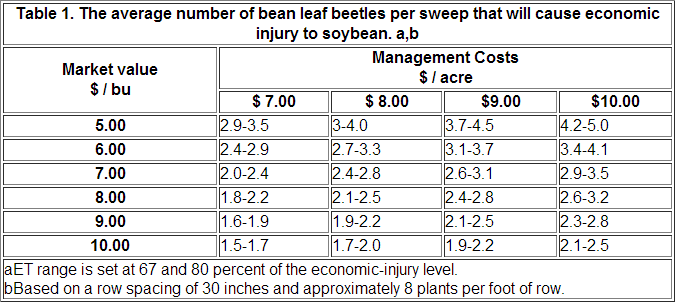
Ground cloth procedure. Place a two-foot wide strip of cloth on the ground between the rows, this provides a four row-foot sample. Bend plants over the cloth and shake them vigorously. Count the number of beetles that fall onto the cloth. Repeat at each sampling location and calculate the average number of beetles per foot row. Consider an insecticide application if the count reaches or exceeds the economic threshold in Table 2.
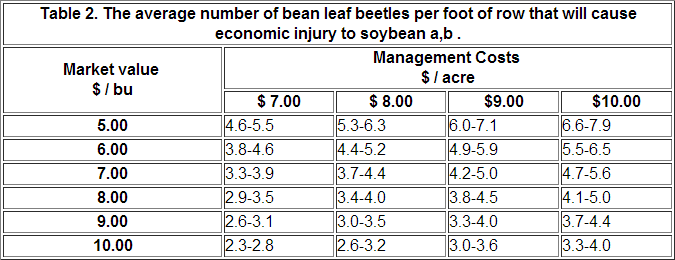
Stand loss:/ defoliation: Control should be considered when 30% of the stand is missing or if 30% defoliation occurs.
Late in the season you must estimate pod damage. This is done by collecting five plant samples at the appropriate number of locations based on field size. Use them to calculate an average number of injured pods per five plants. Consider an insecticide application if the number of injured pods reaches the economic threshold and bean leaf beetles are still present in the field.
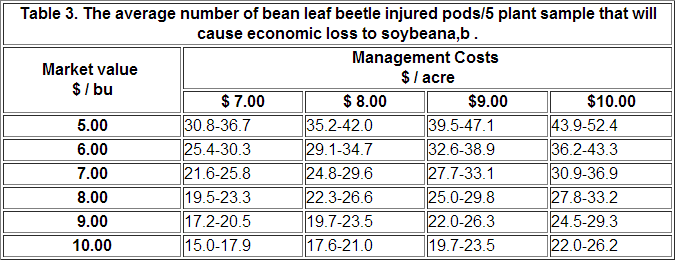
If chemical control is warranted, insecticides recommended for use against BLB may be found in ENT-13.
Other Sources of Information from Kentucky
- IPM-3 Kentucky Integrated Crop Management Manual for Soybeans.
- ENT-13 Insecticide Recommendations for Soybeans.
Additional References
- Davidson, R. H., Lyon, W. F. Insect Pests of Farm, Garden, and Orchard. New York: John Wiley & Sons; 1979.
- Higley, L. G.;Boethel, D. J., editors. Handbook of Soybean Insect Pests. Lanham, MD: Entomological Society of America; 1994.
- Metcalf, R. L.; Metcalf, R. A. Destructive and Useful Insects. New York: McGraw-Hill, Inc. 1993.
- Pedigo, L. P. Entomology and Pest Management. New York: Macmillan Publishing Co.; 1989.
Issued: 4/00
Revised: 4/00
CAUTION! Pesticide recommendations in this publication are registered for use in Kentucky, USA ONLY! The use of some products may not be legal in your state or country. Please check with your local county agent or regulatory official before using any pesticide mentioned in this publication.
Of course, ALWAYS READ AND FOLLOW LABEL DIRECTIONS FOR SAFE USE OF ANY PESTICIDE!
Photo: University of Kentucky IPM Slide Set
